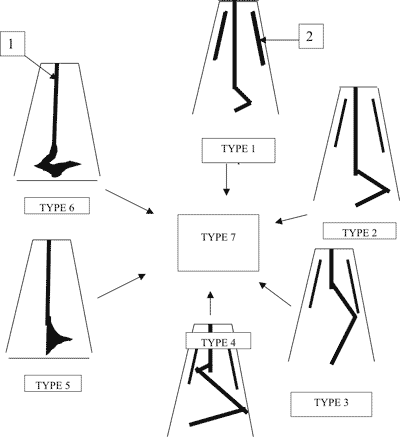© Borgis - New Medicine 4/2007, s. 98-99
*Lechosław P. Chmielik, Magdalena Frąckiewicz, Mieczysław Chmielik
The influence of deformation of nasal septum types Mladina 1, 4 and 6 on the condition of hearing in children
Department of Paediatric Otorhinolaryngology, Medical University, Warsaw, Poland
Head of Department: Prof. Mieczysław Chmielik, MD, PhD
Summary
Summary
Introduction. The occurrence of a correlation between a deformation of the nasal septum and conductive hearing loss in children is widely discussed in the available literature. There are different classifications of the deformation of the nasal septum, in this case the Mladina´s classification – based on the morphological state of the nasal septum, was used. The classification after Mladina includes 7 types of the nasal septum deformation and the type 7 is a combination of types 1 to 6.
Material and methods. The case histories of 240 children, who underwent an operation on the nasal septum in the Paediatric ENT Clinic in Warsaw in the period between 2004 and 2006 were studied. As far as conductive hearing loss is concerned the pure tone audiometry and tympanometry were analyzed.
Results. The results of pure tone audiometry were correct in all children.
Conclusions. Deformations of nasal septum types 1, 4 and 6 are rarely operated on among children. Deformations of the nasal septum types 1, 4 and 6 do not cause dysfunction of the auditory tube or hearing disorders in children.
INTRODUCTION
The occurrence of a correlation between a deformation of the nasal septum and conductive hearing loss in children is widely discussed in the available literature. To determine the type of deformation, we used the classification that is based on the morphological state of the nasal septum and includes a description of the lesion´s shape – Mladina´s classification.
In type 1 a unilateral crest which does not disturb the function of the nasal valve which is placed in the area of the valve is defined. In type 2, a disturbance of the function of the nasal valve occurs, and is caused by the unilateral crest. A positive Cottle´s symptom, which is defined as a subjective and objective improvement, in the patency of the nose after extending the wings of the nostril is present. Type 3 is a unilateral crest at the level of the head of the middle nasal concha. In a type 4 two crests are present, one at the level of the head of the middle nasal concha and the other one situated on the opposite side in the area of the valve, disturbing its function. Type 5 is defined as a occurrence of a unilateral ledge on the base of the nasal septum, on the other side the nasal septum being straight. In type 6 there is a unilateral groove that lies in the caudo-ventral part of the nasal septum, on the other side a ledge is present, with accompanying asymmetry of the bottom of the nasal cavity.
Type 7 is a mixture of types 1 to 6.
MATERIAL AND METHOD
Case histories of 240 children, who had an operation of the nasal septum in the a Paediatric ENT Clinic in Warsaw during 2004-2006 were studied and deformation of Mladina types 1, 4 and 6 were looked for.
In cases in which the nasal septum deformations types 1, 4 or 6 were found the results of pure tone audiometry and tympanometry were analyzed.
RESULTS
In the studied group 2 children had nasal septum deformation type 1, 7 had type 4 and 4 had type 6. The results of pure tone audiometry were correct in all children. In tympanometry, 1 child with a type 4 nasal septum deformation had a type C curve the rest had type A curves.
CONCLUSIONS
1. Deformations of the nasal septum types 1, 4, 6 are rarely operated on in children.
2. Deformations of the nasal septum types 1, 4, 6 do not cause dysfunction of the auditory tube or hearing disorders in children.

Fig. 1. Plans of deformations of the nasal septum, after Mladina
(figures of types 1-4 present a section of nasal cavities in a horizontal plane, whereas the plans of types 5 and 6 present a section of the nasal cavity in a frontal plane 1– nasal septum, 2 – middle nasal concha)
Piśmiennictwo
1. Becker W, et al.: Ear, Nose and Throat Diseasses. G. Thieme Verlag Stattgart 1994; 95. 2. Belenky WM, et al.: Pediatric Otolaryngology, Chmielik M. (red.) 87. Otorynolaryngologia dziecięca. AM Warszawa 2004; 58-59.3. Chmielik LP: Nasal septum deviation and conductivity hearing loss in children. New Medicine 2006 vol IX no.3/2006; 82-86.4. Gray LP: The deviated nasal septum. I. aetiology. J. Laryngol. Otol., 1965; 79: 567-75.5. Hinderer KH.: Nasal problem in children. J. Paediatr. Otolaryngol., 1976; 499.6. Kenna MA, et al.: Practical Pediatric Otolaryngology red. Cotton R.T. print. Lippincott-Raven Philadelphia - New York 1999; 229.7. Krzeski A, Janczewski G: (red.) Choroby nosa i zatok przynosowych, Wydawnictwo Medyczne SANMEDIA Sp.z o.o. Wydanie II. 1998; 275-276.8. Majer W, Krebs A: Is surgery of the inner nose indicated before tympanoplasty. Effects of nasal obstruction and reconstruction on the Eustachian tube. Laryngorhinootologie 1998; 77(12): 682-688.9. Subaric M, Mladina R: Nasal septum deformities in children and adolescents: a cross sectional study of children from Zagreb,Croatia. Int. J. of Ped. ORL 2002; 63: 41-48.10. Szpunar J: System powietrzny wyrostka sutkowatego a schorzenia ucha środkowego. Otolaryngol., Pol. 1967; 2, 213.
